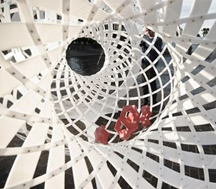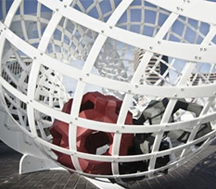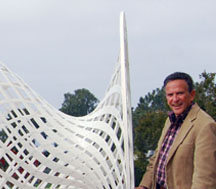Interactive Sculpture Bridges Art and Science
By Cindy Brauer
Science meets art in a new interactive sculpture, Self Assembly Line: From Chaos to Order, recently installed on The Scripps Research Institute’s California campus, outside the main entrance of the Skaggs Institute/Molecular Biology Building. Both a piece of art and a scientific demonstration, the sculpture is a collaboration between Scripps Research Professor Art Olson and Skylar Tibbitts, a designer-architect from the Massachusetts Institute of Technology media lab.
The sculpture demonstrates the process of self-assembly from random interactions, said Olson. The large white cage structure rotates, tumbling the smaller red interior pieces in a random fashion. The interior pieces are based upon the structure of the assembly units of the poliovirus, whose the atomic structure was determined at Scripps Research in the 1980s.
After Tibbitts viewed one of Olson’s YouTube videos (http://www.youtube.com/watch?v=gZxK6j4JTHQ), the two collaborated to build a large-scale version of the scientist’s "virus in a bottle self-assembly” for potential presentation in science and museum venues. The sculpture is constructed of polyethylene plastic, polyurethane foam, and magnets.
Originally commissioned for display at the 2012 TED Conference held February 27-March 2 in Long Beach, California, the artwork, which could not be disassembled, was transported to its present location on campus following the conference. “Since the piece is conceived to be a prototype for installations in both art and science museum venues, we wanted to have it here at Scripps for further testing, robustification, and improvement,” said Olson.
Self-Assembly Line has been greeted with curiosity and enthusiasm on campus. “Once people realize that it is meant to be rotated, and that the individual pieces on the inside, when tumbled, will assemble into a complete sphere, they are quite taken with it,” said Olson. When he sees the installation’s interior pieces assembled, he reaches into the sculpture to pull them apart. “The next time I pass by, the pieces are reassembled, so obviously people are engaging with it quite actively,”
Additional funding for the artwork was provided by the Seed Media Group, whose research arm, Phyllotax Lab, created a website to describe the piece in detail.
Send comments to: press@scripps.edu
















